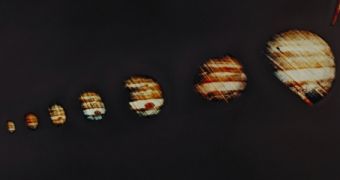The image above is a composite made of photographs snapped by the NASA Pioneer 10 spacecraft as it flew past the gas giant Jupiter on December 4, 1973. The probe was the first man-made object to investigate this planet, and also the first to achieve escape velocity for leaving the solar system.
As Pioneer 10 approached the planet, it was located somewhere behind Jupiter, which means that it only saw the world approaching as a weird crescent-shaped disk. As it turned around it during its pass, its instruments got a chance to see the planet receding until it vanished.
After meeting up with Jupiter, Pioneer 10 continued to fly towards the outer edge of the solar system. In addition to the Jovian world, the spacecraft also analyzed the Inner Asteroid Belt, cosmic rays, the environment around the Sun, and the outer fringes of the heliosphere.
Contact with the vehicle was lost due to a radio transmitter failure on January 23, 2003, as Pioneer 10 was flying around 80 astronomical units from the Sun. An AU is the mean distance between Earth and the Sun, or 157 million kilometers (93 million miles). In all likelihood, the probe is still zooming away from Earth even now.

 14 DAY TRIAL //
14 DAY TRIAL //